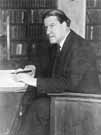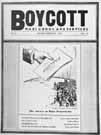
|
|
|

|

|

|

|
|
Click on an image to see a larger, more detailed picture.
|
|
|
|
|
| 1933: The Nazi State Begins |

|
pg. 71 |

|
|
|
|
| |
 Stephen S. Wise
Stephen S. Wise
Rabbi Stephen S. Wise was president of the American Jewish Congress and the World Jewish Congress. Determined to help ease the plight of Germany's Jews, both through the boycott of German goods in the U.S. and an increase in emigration from the Third Reich to Palestine, Wise placed a great deal of hope in U.S. President Franklin Roosevelt. Sadly, Wise's pleas were largely ignored. Wise and other Jewish leaders in America learned about the slaughter of Jews as early as 1942, but their efforts to do something to help Hitler's victims fell on deaf ears. In the end, Wise and the organizations he ran were unable to save many Jews because there was so little interest in their efforts among non-Jews. In a terrible abrogation of responsibility, the international community abandoned Europe's Jews to their fate at the hands of the Nazis.
Photo: Library of Congress/United States Holocaust Memorial Museum Photo Archive
|
 While the government program against German Jews continued unabated inside Germany, the Council of the American Jewish Congress and the Jewish Labor Committee urged their members to boycott German goods and services. The organizations' relatively small memberships, combined with the devastating effects of the Depression, undermined their campaigns. Outside of direct government intervention by the former allies of World War I, little could be done to stop the Nazi juggernaut.
While the government program against German Jews continued unabated inside Germany, the Council of the American Jewish Congress and the Jewish Labor Committee urged their members to boycott German goods and services. The organizations' relatively small memberships, combined with the devastating effects of the Depression, undermined their campaigns. Outside of direct government intervention by the former allies of World War I, little could be done to stop the Nazi juggernaut.
Photo: YIVO Institute for Jewish Research/United States Holocaust Memorial Museum Photo Archive
|
 Ernst Röhm (left), Heinrich Himmler (center), and other Nazi officials arrive at Berlin's Grunewald Stadium for a Party rally. As leader of the Storm Troopers (SA), Röhm commanded a paramilitary force of more than 400,000 men that was charged with eliminating the regime's political opponents. The SA's brutal tactics helped consolidate Hitler's power and made Röhm the second most powerful man in Germany.
Ernst Röhm (left), Heinrich Himmler (center), and other Nazi officials arrive at Berlin's Grunewald Stadium for a Party rally. As leader of the Storm Troopers (SA), Röhm commanded a paramilitary force of more than 400,000 men that was charged with eliminating the regime's political opponents. The SA's brutal tactics helped consolidate Hitler's power and made Röhm the second most powerful man in Germany.
Photo: Ullstein Bilderdienst
|
 The Nazi faithful march in formation at the first Reich Party Day ceremony in Nuremberg, Germany. Battalions of SS soldiers carry eagle standards and flags that proclaim, "Germany Awake." The festivities offered visual evidence of Nazi power.
The Nazi faithful march in formation at the first Reich Party Day ceremony in Nuremberg, Germany. Battalions of SS soldiers carry eagle standards and flags that proclaim, "Germany Awake." The festivities offered visual evidence of Nazi power.
Photo: Bundesarchiv/United States Holocaust Memorial Museum Photo Archive
|
|

|

|

|

|
 November 12, 1933: Nazi candidates win 93 percent of the vote in the Reichstag election. However, only the Nazi Party was permitted to nominate candidates.
November 12, 1933: Nazi candidates win 93 percent of the vote in the Reichstag election. However, only the Nazi Party was permitted to nominate candidates.
|
 November 24, 1933: The German Law Against Dangerous and Habitual Criminals allows for compulsory castration of "hereditary" criminals.
November 24, 1933: The German Law Against Dangerous and Habitual Criminals allows for compulsory castration of "hereditary" criminals.
|
 November 27, 1933: Kraft durch Freude (KdF; Strength through Joy) is established to tie leisure activities of the German Volk (people) to the aims of the Nazi Party.
November 27, 1933: Kraft durch Freude (KdF; Strength through Joy) is established to tie leisure activities of the German Volk (people) to the aims of the Nazi Party.
|
 December 1, 1933: A legal decree issued by Hitler declares Germany and the Nazi Party one.
December 1, 1933: A legal decree issued by Hitler declares Germany and the Nazi Party one.
|
 Late 1933: The German News Bureau (DNB) is established to feed propagandistic "news" to Germany's newspapers.
Late 1933: The German News Bureau (DNB) is established to feed propagandistic "news" to Germany's newspapers.
|
 Late 1933: Hermann Göring orders closure of all SA "wild camps" (locally mandated concentration camps).
Late 1933: Hermann Göring orders closure of all SA "wild camps" (locally mandated concentration camps).
|
 1933-39: More than 1400 anti-Jewish laws are passed in Germany.
1933-39: More than 1400 anti-Jewish laws are passed in Germany.
|
|
|
|
|
| 1933: The Nazi State Begins |

|
pg. 71 |

|
|
The Holocaust Chronicle
© 2009 Publications International, Ltd.
|
|
